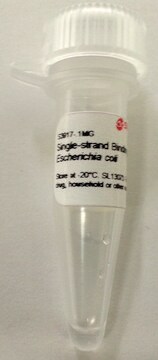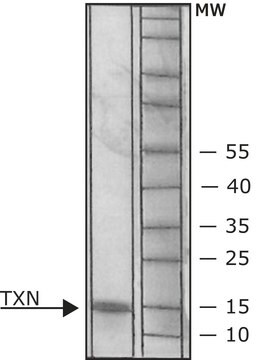Kluczowe dokumenty
F3174
Fpg Protein from Escherichia coli
≥90% (SDS-PAGE), buffered aqueous glycerol solution, >20,000 units/mg protein, suitable for genomic analysis
Synonim(y):
Białko Fpg z Escherichia coli, rekombinowane, DNA-(miejsce apurynowe lub apirymidynowe) liaza MutM (APlyase MutM), Fapy-DNAglikozylaza, Formamidopirymidynowa glikozylaza DNA
About This Item
Polecane produkty
pochodzenie biologiczne
Escherichia coli
Poziom jakości
rekombinowane
expressed in E. coli
Próba
≥90% (SDS-PAGE)
Formularz
buffered aqueous glycerol solution
aktywność właściwa
>20,000 units/mg protein
masa cząsteczkowa
30.2 kDa (269 amino acids, predicted from the nucleotide sequence)
skład
protein, 0.1- 0.3 mg/mL Bradford
warunki przechowywania
(Tightly closed)
metody
nucleic acid detection: suitable
numer dostępu UniProt
Zastosowanie
genomic analysis
Warunki transportu
wet ice
temp. przechowywania
−20°C
informacje o genach
Escherichia coli CFT073 ... mutM(1038243)
Escherichia coli K12 ... mutM(946765)
Opis ogólny
Obszar badań: Sygnalizacja komórkowa
Zastosowanie
Działania biochem./fizjol.
Definicja jednostki
Postać fizyczna
Kod klasy składowania
10 - Combustible liquids
Klasa zagrożenia wodnego (WGK)
WGK 2
Temperatura zapłonu (°F)
Not applicable
Temperatura zapłonu (°C)
Not applicable
Środki ochrony indywidualnej
Eyeshields, Gloves, multi-purpose combination respirator cartridge (US)
Wybierz jedną z najnowszych wersji:
Masz już ten produkt?
Dokumenty związane z niedawno zakupionymi produktami zostały zamieszczone w Bibliotece dokumentów.
Nasz zespół naukowców ma doświadczenie we wszystkich obszarach badań, w tym w naukach przyrodniczych, materiałoznawstwie, syntezie chemicznej, chromatografii, analityce i wielu innych dziedzinach.
Skontaktuj się z zespołem ds. pomocy technicznej






